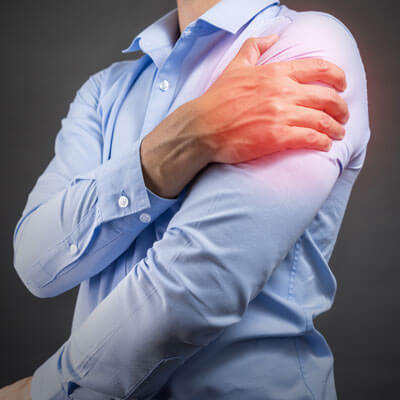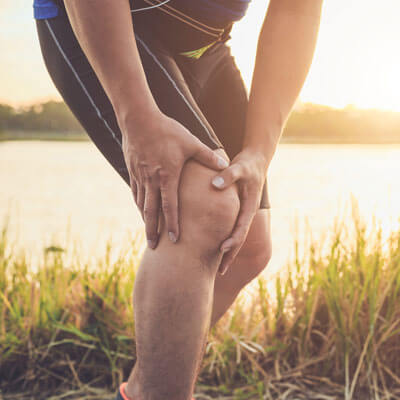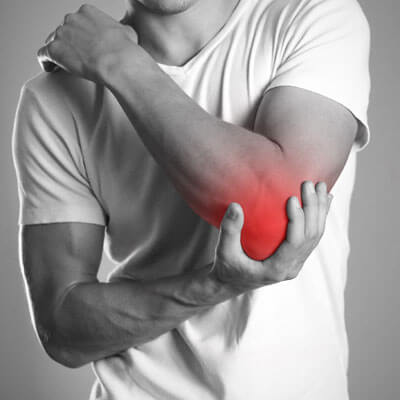Shoulder Pain: How to Find Relief
 Your shoulder is the most unstable and moveable joint in your body. Its wide range of motion occurs due to four primary muscles and their tendons, which together are called the rotator cuff. If your shoulder becomes inflamed or an impingement happens, you may make the mistake of trying to avoid using your arm to help it heal. It may surprise you to learn that not moving can actually contribute to more pain or even lead to a frozen shoulder. Controlled movement is one of the best ways to heal.
Your shoulder is the most unstable and moveable joint in your body. Its wide range of motion occurs due to four primary muscles and their tendons, which together are called the rotator cuff. If your shoulder becomes inflamed or an impingement happens, you may make the mistake of trying to avoid using your arm to help it heal. It may surprise you to learn that not moving can actually contribute to more pain or even lead to a frozen shoulder. Controlled movement is one of the best ways to heal.
Why it Matters:
The most common source of pain in the shoulder is the tendons. Your tendons attach the muscles of the shoulder to the bones. If a tendon becomes trapped, it can result in shoulder impingement. If a tendon becomes inflamed, you may hear it referred to as tendinitis or bursitis. And if a tendon becomes torn, you guessed it; you have a rotator cuff tear.
- Shoulder Bursitis: If the sac of fluid that cushions your shoulder becomes swollen and painful due to repetitive motions, you may have bursitis.
- Shoulder Impingement: If your tendons get pinched between or under the bones of your shoulder, it can lead to impingement. Lifting overhead repetitively can cause impingement, and it can result in swelling and pain.
- Rotator Cuff Tear: Your rotator cuff can become damaged due to overuse, injury, or age. Tears usually cause pain when you try to lift things, and you may hear a popping sound as you move.
Your shoulder and spine work together. While it may seem like they are two completely different areas, it’s been discovered that postural abnormalities can play a significant role in your likelihood of developing shoulder pain. Maintaining a full range of motion in your shoulder and spinal joints of your neck and mid-back can help reduce your chances of dealing with shoulder pain. If you notice shoulder discomfort or restricted movement, contact us for a complete evaluation. We’ll work to create a movement-based plan to help you find long-term relief.
Your Hip vs. SI Joint: What’s the Difference?
It can be extremely confusing to figure out the difference between hip and SI (sacroiliac) joint pain. But being able to identify which one is the culprit is crucial when you are looking to find relief. Your SI joint is the connection between your tailbone (sacrum) and your pelvis. The SI joint is very fibrous and only moves a few millimeters. On the other hand, your hip is much less stable and allows your entire leg to move in every plane of motion.
Why it Matters:
While the hip and SI joints are very different in structure and function, they share similar pain patterns, making it difficult to tell one from the other. It’s common to have SI joint pain mimic low back pain. Bending backward usually aggravates SI joint pain due to the compression that happens in the joint as you move.
Hip pain is more likely to occur when you walk or if you try to bring your knees to your chest.
- Hip Pain: Characterized by pain with walking, weight-bearing, and rotating the leg.
- SI Joint Pain: Difficulties while standing, walking, climbing stairs, getting out of the car.
- Low Back Pain: Pain that radiates into the buttock or leg and may travel down to the foot.
Suppose you’ve felt discomfort and aren’t exactly sure if it’s your hip, SI joint, or low back- it’s important to find a chiropractor who will provide a complete evaluation and treatment plan. The reason this is important is that our hips tend to become degenerative as we age, and if your doctor is only looking at a hip X-ray to determine a plan of care- you may find yourself getting treatment for a problem you don’t have. We take a holistic approach to our evaluations, and our movement assessments ensure that we can pinpoint your challenges so that you get the best care plan to live your highest quality of life.
Are You At Risk for Chronic Knee Pain?
 Knees hurt? You’re not alone. Chronic knee pain is thought to affect up to 25% of adults and can significantly limit your mobility and quality of life. Your knee is a hinge-joint that primarily moves back and forth (flexion and extension) and allows some twisting or rotation. Every step you take places stress and strain on your knees, so it’s no surprise that trauma, misalignment, and degenerative changes can all take their toll.
Knees hurt? You’re not alone. Chronic knee pain is thought to affect up to 25% of adults and can significantly limit your mobility and quality of life. Your knee is a hinge-joint that primarily moves back and forth (flexion and extension) and allows some twisting or rotation. Every step you take places stress and strain on your knees, so it’s no surprise that trauma, misalignment, and degenerative changes can all take their toll.
Why it Matters:
While knee pain may not be entirely preventable, there are steps you can take to keep your knees as healthy as possible. At the top of the list is to watch your weight. For every pound you are overweight, your knee must absorb an extra 4 pounds of pressure when you walk, run or climb stairs. In addition, the cartilage in your knee is designed to last a lifetime if you take care of it.
Here are a few additional ways to keep your knees healthy and strong.
- Warm-Up Before Exercising: Stretching your quadriceps and hamstrings before and after you exercise is a smart way to reduce the chance of a flare-up of knee pain.
- Find Adequate Foot Support: Every step you take transfers force from the bottom of your foot to your knee. Therefore, your shoes should provide the support you need to keep your knees healthy for at least 10,000 steps per day.
- Maintain a Full Range of Motion: Ensuring your low back and hips are moving freely is essential to overall knee health.
The joints of your body should have a balance of strength and flexibility through their full range of motion. Unfortunately, it’s not uncommon for people with back issues to find themselves struggling with knee pain after limping around for a few weeks. We encourage our patients to be proactive with their health. Use the strategies above to help reduce your chances of knee pain, and be sure to call our practice if you notice any pain or restricted motion.
Tennis Elbow? But I don’t even play tennis!
 Tennis elbow isn’t just for athletes. Lateral epicondylitis (tennis elbow) is a painful condition that occurs when the tendons in your elbow are inflamed and overloaded due to repetitive motion. Because of the motion that occurs when swinging a racket, it’s commonly referred to as tennis elbow, but anyone who has a job that features repetitive arm motions may be at risk.
Tennis elbow isn’t just for athletes. Lateral epicondylitis (tennis elbow) is a painful condition that occurs when the tendons in your elbow are inflamed and overloaded due to repetitive motion. Because of the motion that occurs when swinging a racket, it’s commonly referred to as tennis elbow, but anyone who has a job that features repetitive arm motions may be at risk.
Why it Matters:
Tennis elbow can become a serious issue because of the pain and weakness that make it difficult to perform your daily tasks. Because it’s an injury caused by repetitive motions, and since many of these motions are essential to your job, finding ways to decrease the inflammation and improve biomechanics is critical. Three natural ways to help reduce the pain associated with tennis elbow include:
- Rest: Giving your arm time to rest is important to stop the cascade of inflammation and pain.
- Ice: Icing, a few times per hour, is a smart strategy to reduce pain and inflammation.
- Technique: Be mindful of how you are moving your arm, use proper ergonomics, and use a brace for a short time if necessary.
Tennis elbow is usually not a condition that will go away on its own. However, we’ve found two key strategies for reducing the pain associated with tennis below. First is receiving a plan of care that includes at-home exercises to strengthen your supporting muscles. The second is receiving adjustments, when necessary, to improve the motion and movement of your elbow joints. If you or someone you know has struggled with tennis elbow, give us a call so that we can provide you with a plan to find relief.
Science Source:
Immediate Effects of Spinal Manipulation on Shoulder Pain. J Chiropr Med. 2019.
Sacroiliac Joint Dysfunction. Spine-Health. 2018.
Chronic Knee Pain. Healthline. 2019.
Tennis Elbow. Orthoinfo by the American Academy of Orthopedic Surgeons. 2020.
